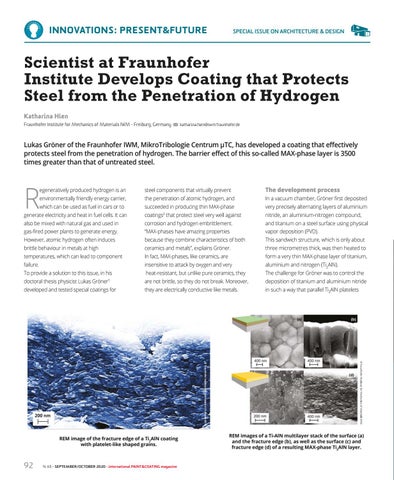INNOVATIONS: PRESENT&FUTURE
SPECIAL ISSUE ON ARCHITECTURE & DESIGN
Scientist at Fraunhofer Institute Develops Coating that Protects Steel from the Penetration of Hydrogen Katharina Hien Fraunhofer Institute for Mechanics of Materials IWM - Freiburg, Germany
katharina.hien@iwm.fraunhofer.de
Lukas Gröner of the Fraunhofer IWM, MikroTribologie Centrum μTC, has developed a coating that effectively protects steel from the penetration of hydrogen. The barrier effect of this so-called MAX-phase layer is 3500 times greater than that of untreated steel.
R
egeneratively produced hydrogen is an
steel components that virtually prevent
The development process
environmentally friendly energy carrier,
the penetration of atomic hydrogen, and
In a vacuum chamber, Gröner first deposited
which can be used as fuel in cars or to
succeeded in producing thin MAX-phase
very precisely alternating layers of aluminium
generate electricity and heat in fuel cells. It can
coatings2 that protect steel very well against
nitride, an aluminium-nitrogen compound,
also be mixed with natural gas and used in
corrosion and hydrogen embrittlement.
and titanium on a steel surface using physical
gas-fired power plants to generate energy.
“MAX-phases have amazing properties
vapor deposition (PVD).
However, atomic hydrogen often induces
because they combine characteristics of both
This sandwich structure, which is only about
brittle behaviour in metals at high
ceramics and metals”, explains Gröner.
three micrometres thick, was then heated to
temperatures, which can lead to component
In fact, MAX-phases, like ceramics, are
form a very thin MAX-phase layer of titanium, aluminium and nitrogen (Ti2AlN).
failure.
insensitive to attack by oxygen and very
To provide a solution to this issue, in his
heat-resistant, but unlike pure ceramics, they
doctoral thesis physicist Lukas Gröner
are not brittle, so they do not break. Moreover,
deposition of titanium and aluminium nitride
developed and tested special coatings for
they are electrically conductive like metals.
in such a way that parallel Ti2AlN platelets
1
92
N. 65 - SEPTEMBER/OCTOBER 2020 - international PAINT&COATING magazine
© Fraunhofer Institute for Mechanics of Materials IWM
© Fraunhofer Institute for Mechanics of Materials IWM
REM image of the fracture edge of a Ti2AlN coating with platelet-like shaped grains.
The challenge for Gröner was to control the
REM images of a Ti-AlN multilayer stack of the surface (a) and the fracture edge (b), as well as the surface (c) and fracture edge (d) of a resulting MAX-phase Ti2AlN layer.
